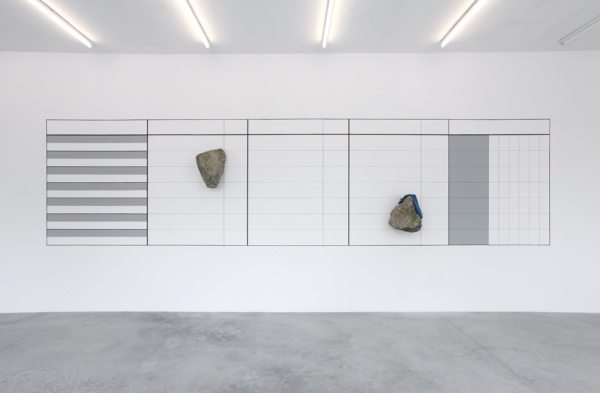Gabriel Kuri
Thursday, 16 May 2013
Gabriel Kuri
Work from “punto y línea en el altiplano“.
“Galleria Franco Noero announce the opening of its new exhibition space in Turin, with “punto y línea en el altiplano,” an exhibition of new works by Gabriel Kuri. This is the third solo show of the Mexican artist for the gallery.
Shown in the former factory building converted to a design by Flavio Albanese, the series of works illustrates the ongoing development of Kuri’s most characteristic themes: an analysis of the nature of sculpture and of its potential in terms of form, together with the possibilities opened up by combining different elements, whether found or made, in a way that augments their intrinsic material and tactile qualities.
Beneath the large skylight in the central space of the Gallery, the notions of monumentalism, balance, weight and gravity are simultaneously expressed in a sculpture consisting of elements that interact with each other as mirror images: a skip for rubble is surprisingly tipped up at 45°, counteracting a thick sheet of steel gently curved into an L-shape and painted in a neutral colour. As the result of an industrial process, the metal contrasts withnature, in the form of two large stones thatanchor them to the ground,establishing a balance of composition and tension between horizontal and vertical.
The twists and turns of a segmented line of solid colour nearby wind through space, unfurling a continuous series of painted metal tubes joined together by curved linkages. In these “broken lines”, as Kuri calls them, the smooth, coaxing quality of the curves contrasts with the sharp, pointed starkness of the anti-pigeon spikes that cover them like a thorny mantle. Like drops of rain or an imaginary celestial constellation, copper-coloured coins are scattered on the floor beneath them.
Opposite the large strip windows on Via Mottalciata, a long unbroken wall defines a space that reveals other characteristic aspects of Kuri’s work. These are the parallels between the abstraction of economic systems and abstraction in art, the link between the immanence of everyday life and the horizon formed by universality, to the habits of social life and to human presence, and the desire for the work of art to come alive through them.
The entire wall is covered with hand-drawn coordinates from a calculation book, a system that is interrupted by two quarry-rough stones that mysteriously appear to lose their weight – a double phrasing like notes on a musical score. On one of the stones a sweater that seems abandoned quotes the physical presence through the absence in the form of the discarded clothing.
Further on a progression of metal trestles painted grey, designed by Kuri, become the sloping horizon on which a soft, undulating “tongue” of linoleum unfolds: blown-up microchips emerge on the surface, where natural stones are also resting. The irregularly wavy shapes of the linoleum recall a section of a landscape, the crest of a downward slope, but our attention is also shifted to the deviation in size of the microchips, which are at variance with what they are, thus becoming a succinct graphic sign.
Perpendicular to this is what Kuri calls an “alignment”. This is a neatly arranged series of different objects that are placed in an empathetic relationship, as though run through by a flow of energy and ideas. This plays on the concept of line, of breakage and juxtaposition, of heights, planes and volumes, making every object capable of presenting all its characteristics individually but also within a global “system”, endowing each one with the same level of aesthetic dignity.” – Galleria Franco Noero, Turin



